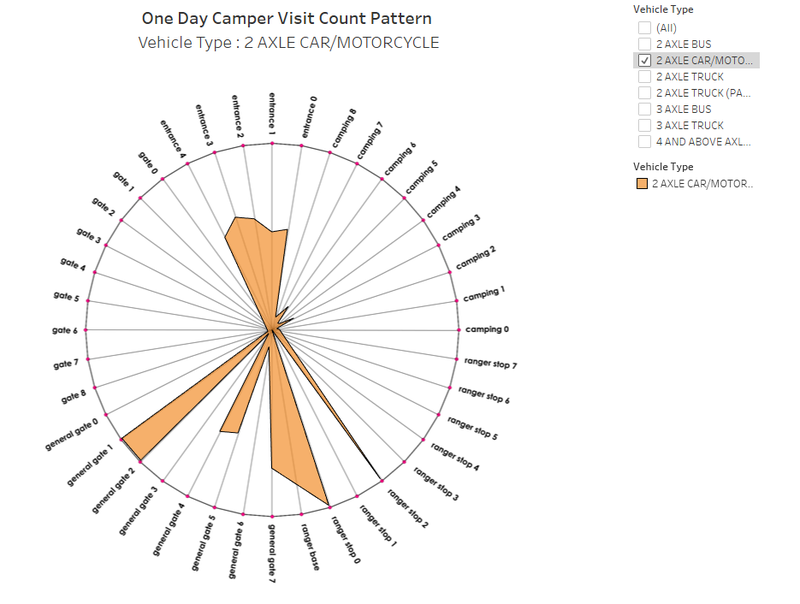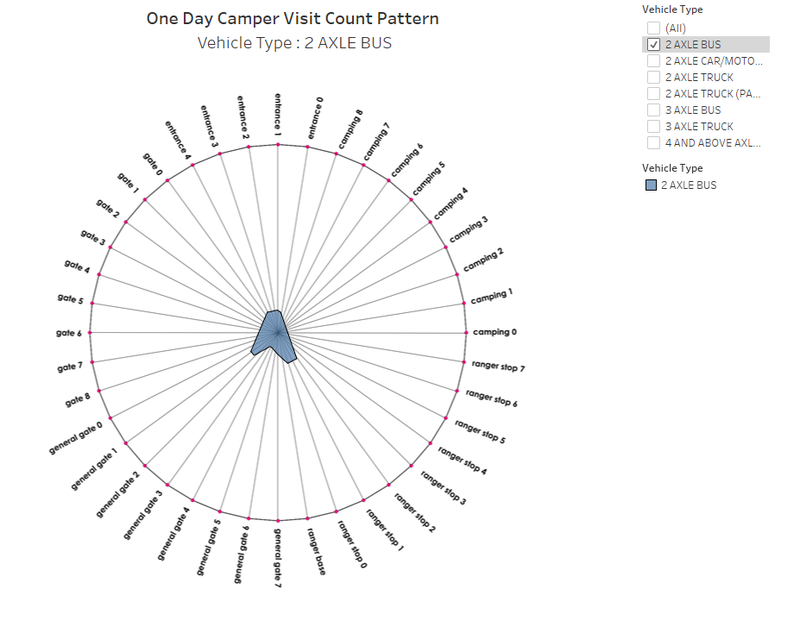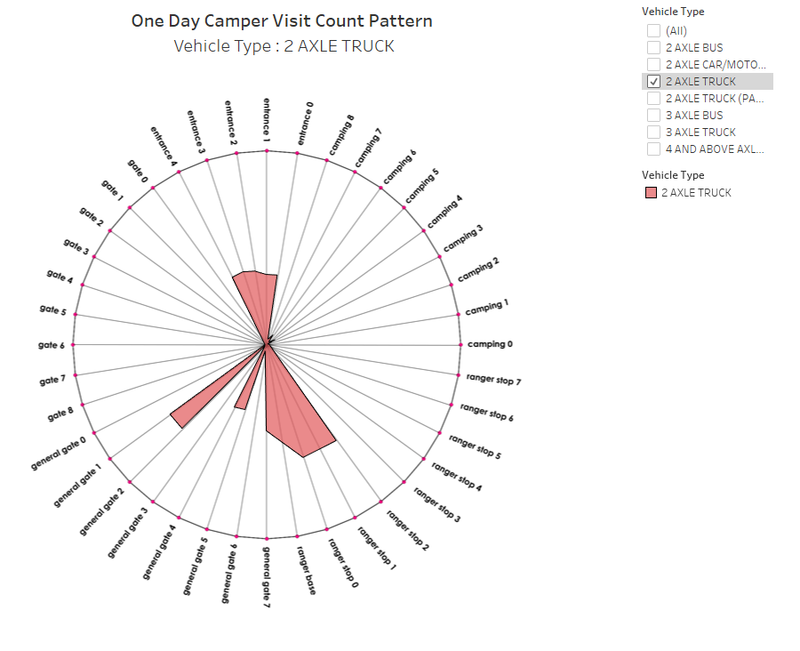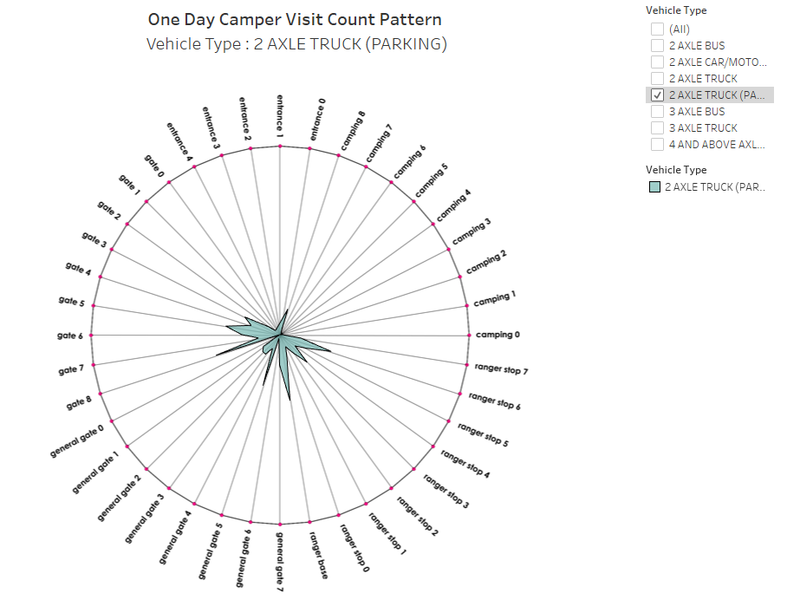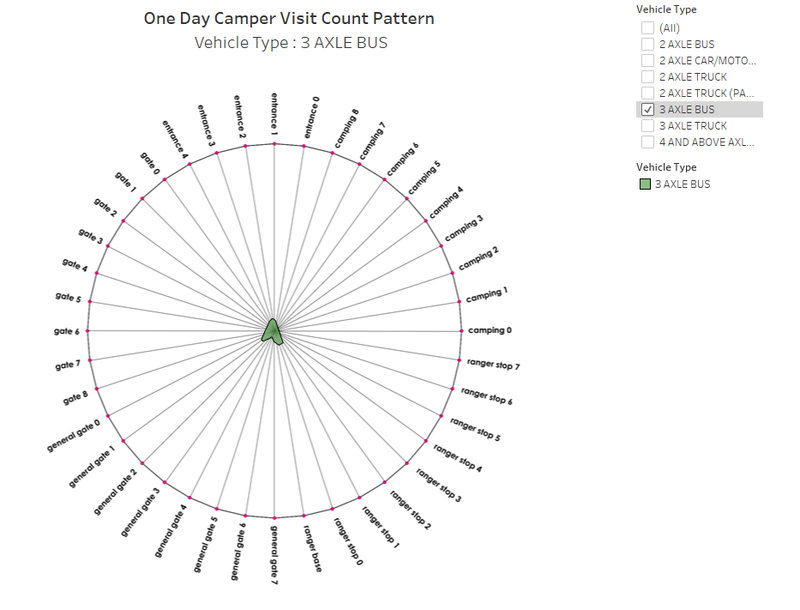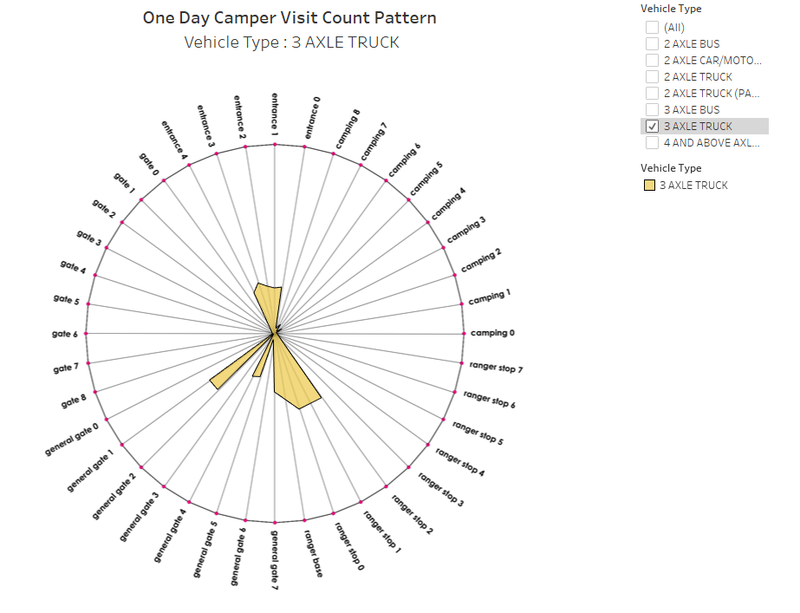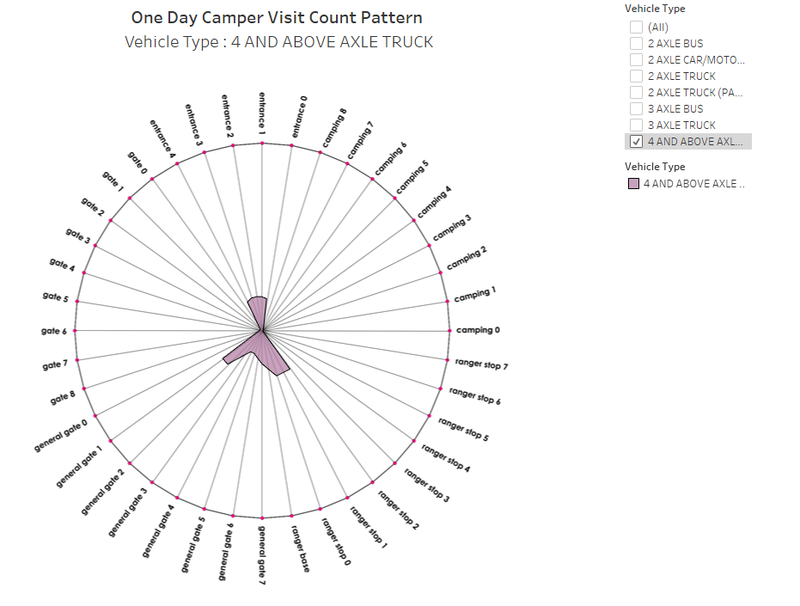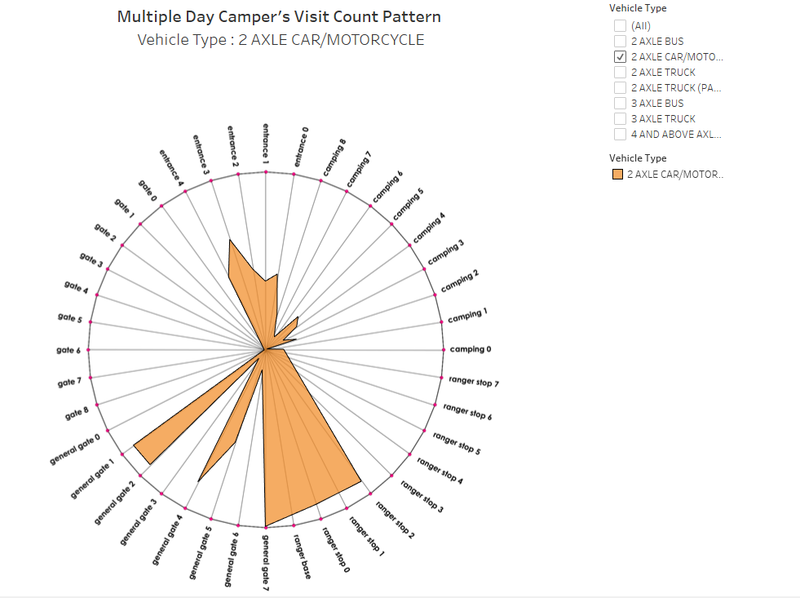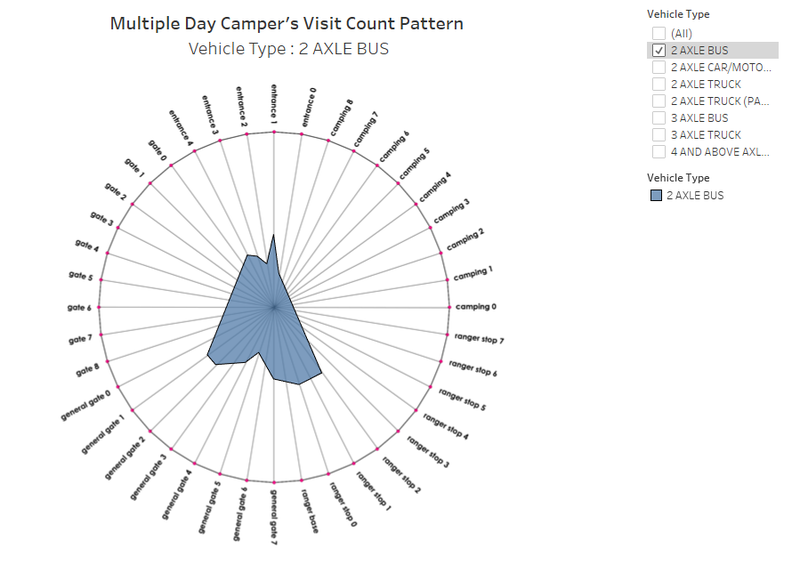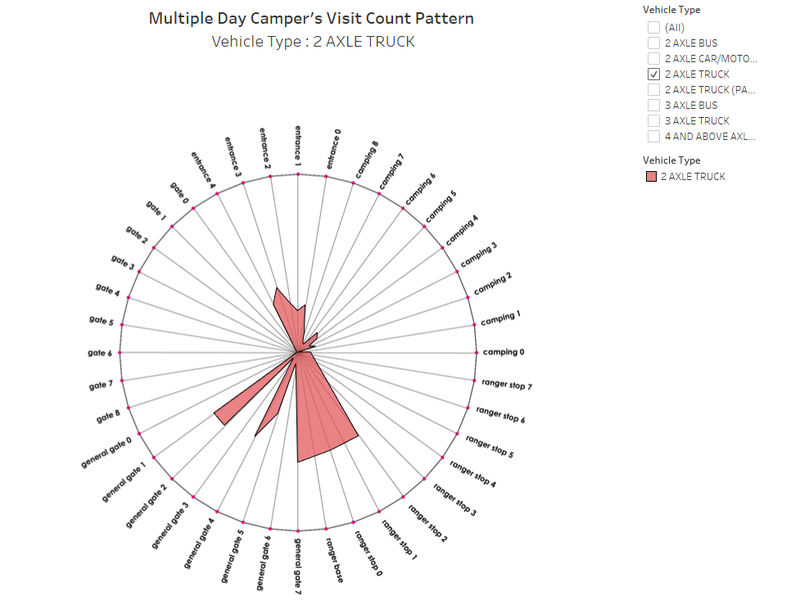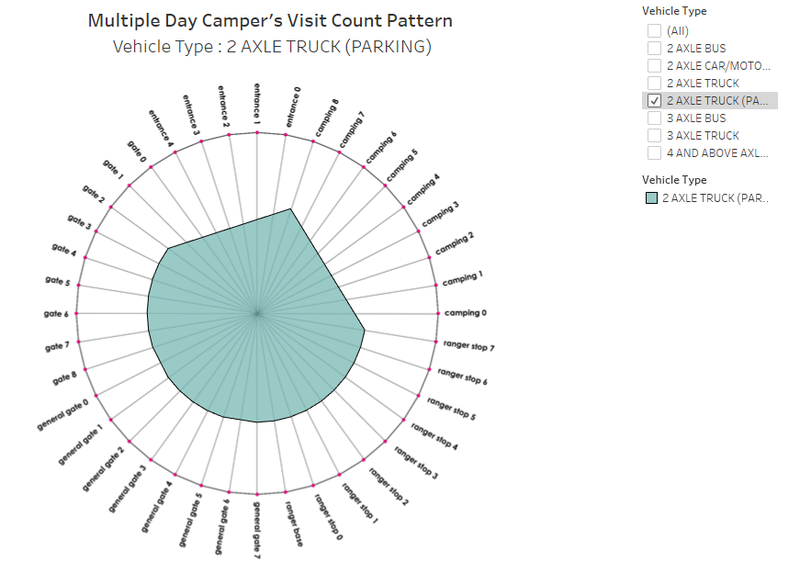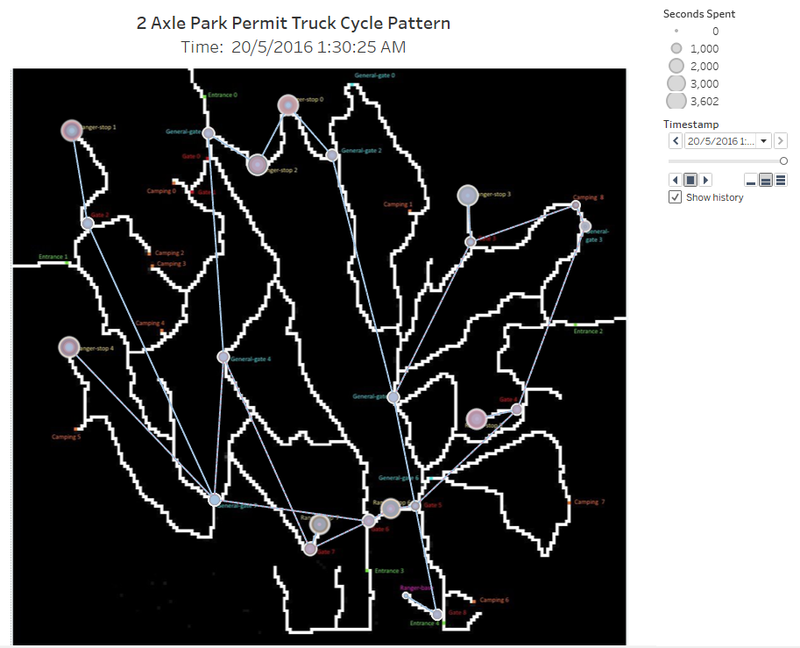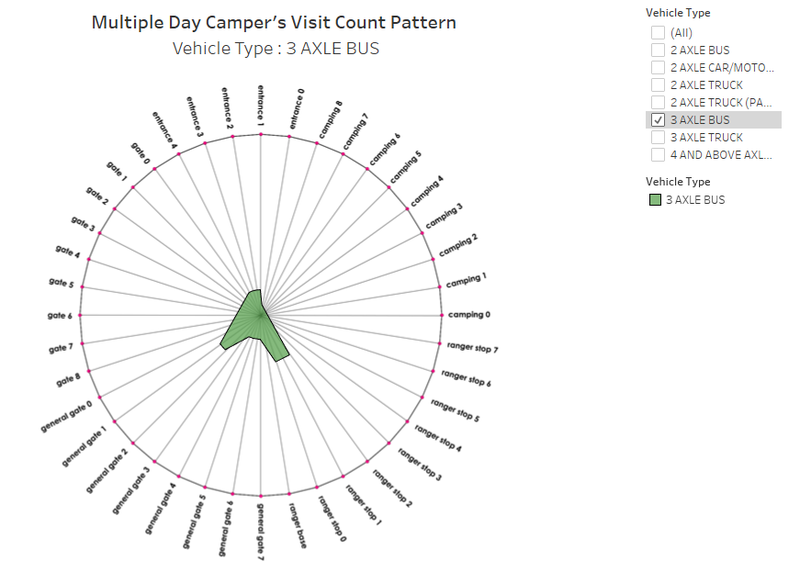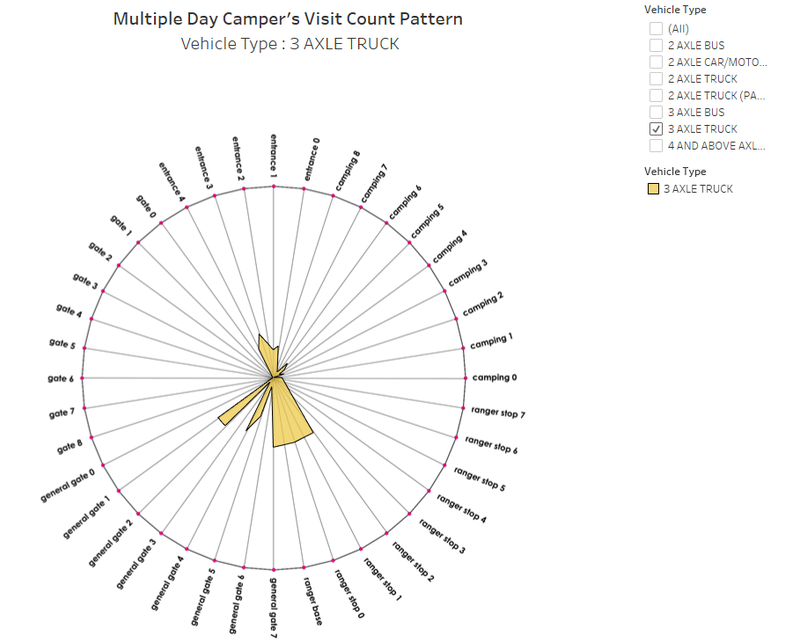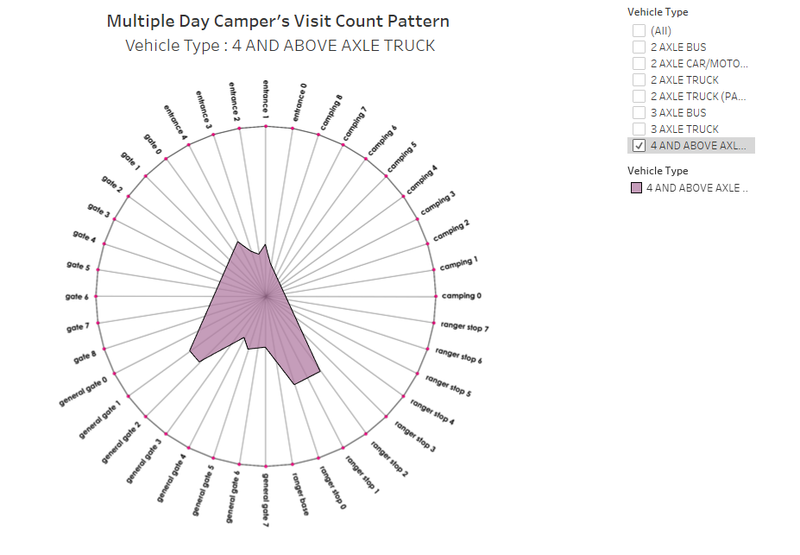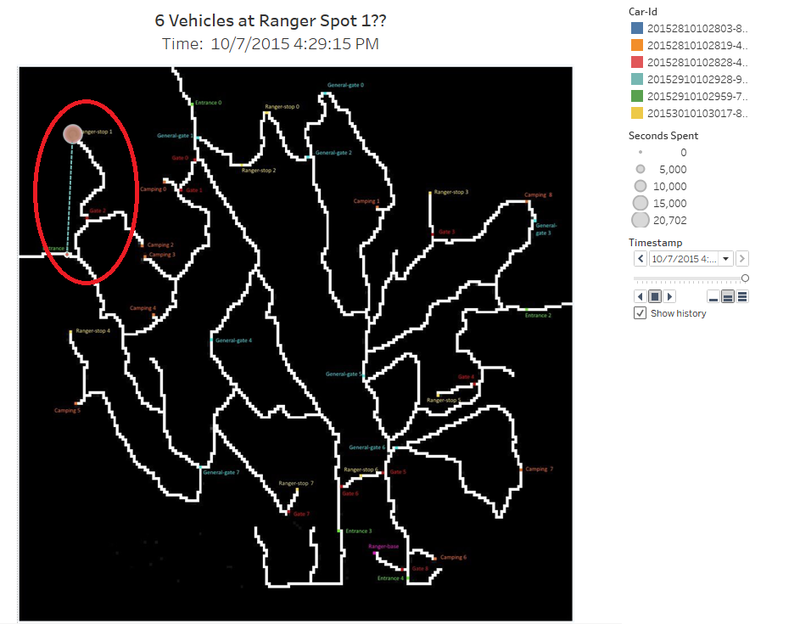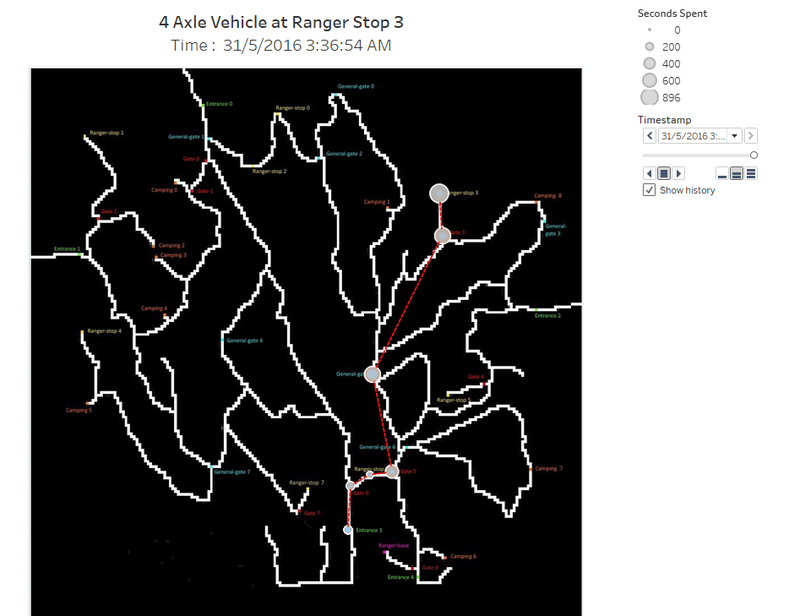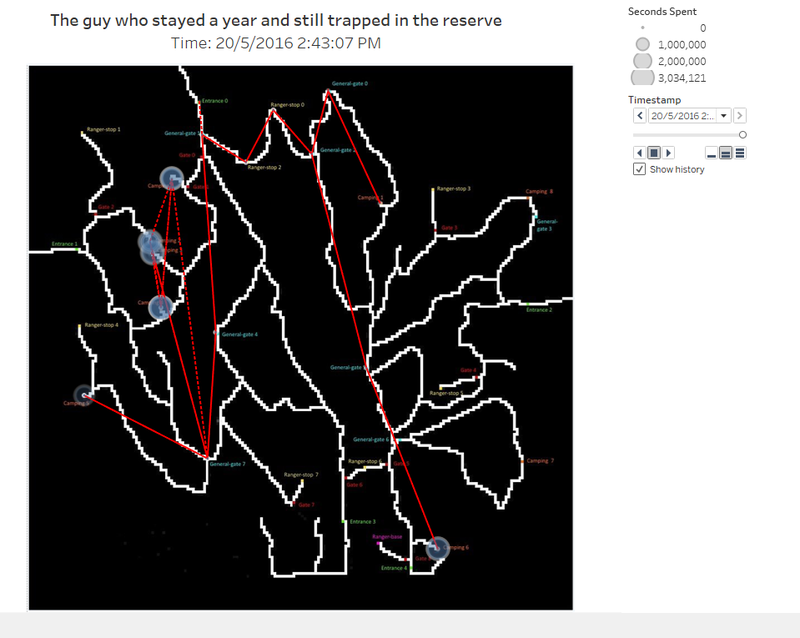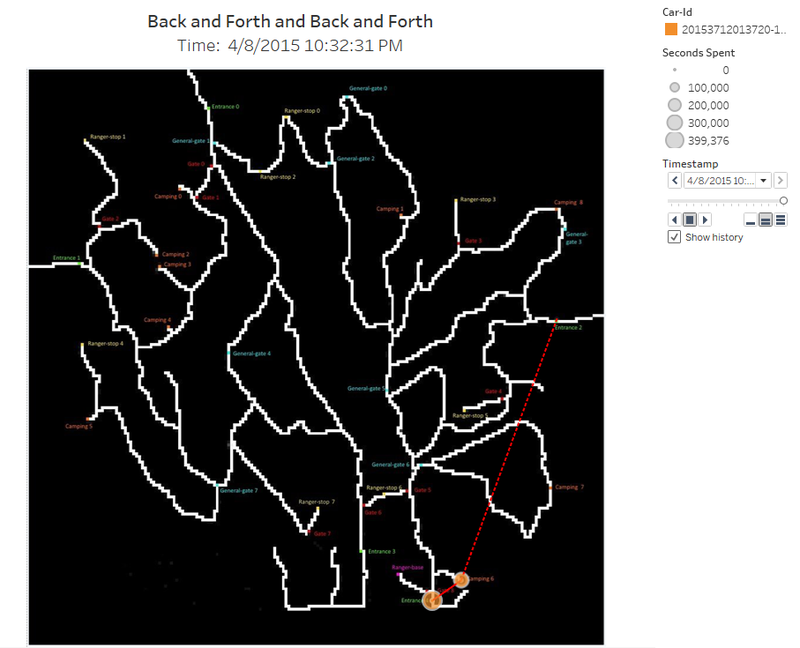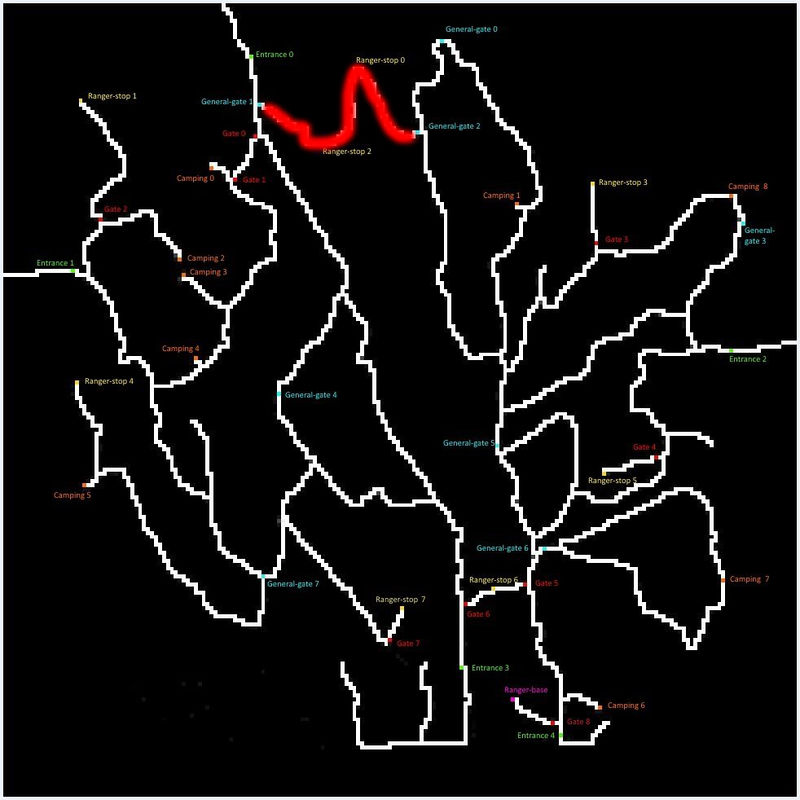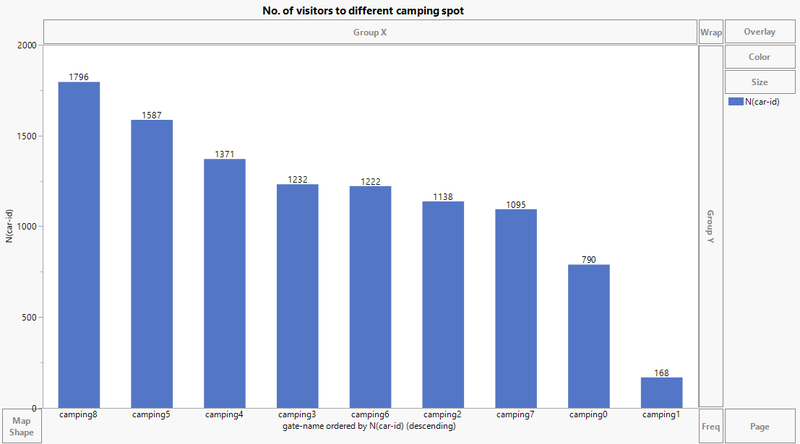Difference between revisions of "ISSS608 2016-17 T3 ROGER INSIGHTS"
Rogers.2016 (talk | contribs) |
|||
| (28 intermediate revisions by 3 users not shown) | |||
| Line 43: | Line 43: | ||
<br /> | <br /> | ||
[[File:2 Axle Car Motorcycle 1 Day.png|800px|centre]] | [[File:2 Axle Car Motorcycle 1 Day.png|800px|centre]] | ||
| + | <br /> | ||
Traffic starts from 6 AM and leaves the reserve by 6 PM. Few visitors spent a lot of time in camping areas whereas the rest were exploring , trying to cover many areas inside the reserve within a day. A lot of people crossed past general gates 1 and 2 and ranger stop 0 and 2. No vehicles go near the gate area as they are prevented from entering into the ranger spots. Most of the traffic are passing by general gates to different camping areas. Around 6 drivers were observed at ranger spot 1 during the day which will be explained later. While returning back late night most of the vehicles are observed passing through general gates 1 and 2 and ranger stop 0 and 2. Out of 4,134 motorcycles 66.3% are observed using the above route. | Traffic starts from 6 AM and leaves the reserve by 6 PM. Few visitors spent a lot of time in camping areas whereas the rest were exploring , trying to cover many areas inside the reserve within a day. A lot of people crossed past general gates 1 and 2 and ranger stop 0 and 2. No vehicles go near the gate area as they are prevented from entering into the ranger spots. Most of the traffic are passing by general gates to different camping areas. Around 6 drivers were observed at ranger spot 1 during the day which will be explained later. While returning back late night most of the vehicles are observed passing through general gates 1 and 2 and ranger stop 0 and 2. Out of 4,134 motorcycles 66.3% are observed using the above route. | ||
| Line 50: | Line 51: | ||
<br /> | <br /> | ||
[[File:2 Axle Bus 1 Day.png|800px|centre]] | [[File:2 Axle Bus 1 Day.png|800px|centre]] | ||
| + | <br /> | ||
These vehicles are seen at general gates and entrances. As these vehicles are not seen at general gates 3 and 6, it can be hypothesized that these vehicles does not have permit access to enter these route. They pass through the rest of general gates, entrances and through ranger spots 0 and 2. They are not seen at camping sites, which can again be hypothesized that they might not have the permit to enter the same. They pass from one entrance to another via general gates. A 2 axle bus usually roams for around 40-45 mins (max 1 hr) inside the preserve. This implies that it can used for logistics or other transportation purposes and probably not for tourist purposes. The reason they might not be used for touring purposes is because they don't follow a regular pattern in their movements. At any hour an average of 15-20 axle buses run inside the preserve. | These vehicles are seen at general gates and entrances. As these vehicles are not seen at general gates 3 and 6, it can be hypothesized that these vehicles does not have permit access to enter these route. They pass through the rest of general gates, entrances and through ranger spots 0 and 2. They are not seen at camping sites, which can again be hypothesized that they might not have the permit to enter the same. They pass from one entrance to another via general gates. A 2 axle bus usually roams for around 40-45 mins (max 1 hr) inside the preserve. This implies that it can used for logistics or other transportation purposes and probably not for tourist purposes. The reason they might not be used for touring purposes is because they don't follow a regular pattern in their movements. At any hour an average of 15-20 axle buses run inside the preserve. | ||
| Line 58: | Line 60: | ||
<br /> | <br /> | ||
[[File:2 Axle Truck 1 Day.png|800px|centre]] | [[File:2 Axle Truck 1 Day.png|800px|centre]] | ||
| − | Traffic for these vehicles starts from 6 AM and leaves park by 6 PM. These vehicles | + | <br /> |
| + | Traffic for these vehicles starts from 6 AM and leaves park by 6 PM. These vehicles are seen at other camping spots. Only few of these vehicles pass through general gate 3 and 6 and hence only less vehicles are observed at camping spot 7. Hypothesis is that 2 axle trucks carry visitors and drops at camping points and take them back or they belong to individual or to a private company and only a few of them take breaks at camping spots. However, after 6 PM it roams around general gates but does not enter camping spots. | ||
| Line 66: | Line 69: | ||
<br /> | <br /> | ||
[[File:2 Axle Truck Parking 1 Day.png|800px|centre]] | [[File:2 Axle Truck Parking 1 Day.png|800px|centre]] | ||
| + | <br /> | ||
These 2 axle trucks are mostly visible at general gates and ranger stop areas. Most of these vehicles are present at ranger base and ranger stop 6. Work happens more at ranger stop 6 for which they access mostly by gate 5. No vehicles are observed at entrances. Few vehicles are parked at camping areas for few hours. Hence these vehicles with parking permit are used by ranger workers within the reserve. No information about the vehicles post 11 PM and before 6 AM are provided. Only few passes through gate 2 i.e. to ranger stop 1. | These 2 axle trucks are mostly visible at general gates and ranger stop areas. Most of these vehicles are present at ranger base and ranger stop 6. Work happens more at ranger stop 6 for which they access mostly by gate 5. No vehicles are observed at entrances. Few vehicles are parked at camping areas for few hours. Hence these vehicles with parking permit are used by ranger workers within the reserve. No information about the vehicles post 11 PM and before 6 AM are provided. Only few passes through gate 2 i.e. to ranger stop 1. | ||
| Line 73: | Line 77: | ||
<br /> | <br /> | ||
[[File:3 Axle Bus 1 Day.png|800px|centre]] | [[File:3 Axle Bus 1 Day.png|800px|centre]] | ||
| + | <br /> | ||
These vehicles similar to 2 Axle Bus does not pass through the general gates 3 and 6. They don’t go to camping sites and gates. These vehicles only accesses entrance gates and general gates, ranger stops 0 and 2. A 3 axle bus usually roams for around 40-45 mins (max 1 hr) inside the preserve. This implies that they can be used for logistics or other transportation purposes and not for tourist purposes. | These vehicles similar to 2 Axle Bus does not pass through the general gates 3 and 6. They don’t go to camping sites and gates. These vehicles only accesses entrance gates and general gates, ranger stops 0 and 2. A 3 axle bus usually roams for around 40-45 mins (max 1 hr) inside the preserve. This implies that they can be used for logistics or other transportation purposes and not for tourist purposes. | ||
| Line 80: | Line 85: | ||
<br /> | <br /> | ||
[[File:3 Axle Truck 1 Day.png|800px|centre]] | [[File:3 Axle Truck 1 Day.png|800px|centre]] | ||
| + | <br /> | ||
Almost 65% 1171 out of 1780 of these vehicles pass through general gate 1,2 and ranger stop 0 and ranger stop 2. Rest flow through other general gates and don't pass near gates. Few trucks take break at camping and mostly they might be used for transportation and logistic purposes. They spend longer time than 2 axle or 3 axle bus. Hence these vehicles mostly belong to distant travelers who take long breaks. | Almost 65% 1171 out of 1780 of these vehicles pass through general gate 1,2 and ranger stop 0 and ranger stop 2. Rest flow through other general gates and don't pass near gates. Few trucks take break at camping and mostly they might be used for transportation and logistic purposes. They spend longer time than 2 axle or 3 axle bus. Hence these vehicles mostly belong to distant travelers who take long breaks. | ||
| Line 88: | Line 94: | ||
<br /> | <br /> | ||
[[File:4 Axle Truck 1 Day.png|800px|centre]] | [[File:4 Axle Truck 1 Day.png|800px|centre]] | ||
| + | <br /> | ||
These vehicles similar to 2 and 3 Axle Bus does not pass through the general gates 3 and 6 and hence they don't enter camping 7. It is also found that they don't go to camping sites ans gates. These are mostly vehicles that are used for transportation and logistics purposes and not for tourist purposes. But around 23 vehicles pass through gates 3,5 and 6 and also went to ranger stops 3 and 6. This is an unusual behavior that will be explained later. | These vehicles similar to 2 and 3 Axle Bus does not pass through the general gates 3 and 6 and hence they don't enter camping 7. It is also found that they don't go to camping sites ans gates. These are mostly vehicles that are used for transportation and logistics purposes and not for tourist purposes. But around 23 vehicles pass through gates 3,5 and 6 and also went to ranger stops 3 and 6. This is an unusual behavior that will be explained later. | ||
<br/> | <br/> | ||
| − | <big><big>''' | + | <big><big>'''2. Multiple Day Camper's Patterns'''</big></big> |
<br /> | <br /> | ||
<br /><br /> | <br /><br /> | ||
| Line 98: | Line 105: | ||
<br /> | <br /> | ||
[[File:2 Axle Car Motorcycle many days.png|800px|centre]] | [[File:2 Axle Car Motorcycle many days.png|800px|centre]] | ||
| + | <br /> | ||
These multiple day visitors are usually people who stay at camps for multiple days like a getaway vacation. Hence no hourly traffic pattern is observed as many visitors visit different camping spots at different time.However, very less visitors spend time at camping 1. They don’t go into any other gates or ranger stops. So no trespassing actions are observed. More than 90% stay for 2 days. Only 10% or less people stay more than 2 days. But 1 person stays for more than a year spends a lot of time at different camping spots which is unusual. | These multiple day visitors are usually people who stay at camps for multiple days like a getaway vacation. Hence no hourly traffic pattern is observed as many visitors visit different camping spots at different time.However, very less visitors spend time at camping 1. They don’t go into any other gates or ranger stops. So no trespassing actions are observed. More than 90% stay for 2 days. Only 10% or less people stay more than 2 days. But 1 person stays for more than a year spends a lot of time at different camping spots which is unusual. | ||
| + | |||
| + | <br /> | ||
| + | <br /> | ||
| + | <big>'''b. 2 Axle Bus'''</big> | ||
| + | <br /> | ||
| + | [[File:2 Axle Bus Multiple Day.png|800px|centre]] | ||
| + | <br /> | ||
| + | These buses are no different from 2 Axle Bus on a single day except that the bus enters into the preserve post 11 PM and reaches the exit post 12 AM the next day. Hence the average travel time is close to 40 minutes. These vehicles are seen at general gates and entrances. As these vehicles are not seen at general gates 3 and 6, it can be hypothesized that these vehicles does not have permit access to enter these route. They pass through the rest of general gates, entrances and through ranger spots 0 and 2. They are not seen at camping sites, which can again be hypothesized that they might not have the permit to enter the same. They pass from one entrance to another via general gates. A 2 axle bus usually roams for around 40-45 mins (max 1 hr) inside the preserve. This implies that it can used for logistics or other transportation purposes and probably not for tourist purposes. The reason they might not be used for touring purposes is because they don't follow a regular pattern in their movements. At any hour an average of 15-20 axle buses run inside the preserve. | ||
| + | |||
| + | |||
| + | <br /> | ||
| + | <br /> | ||
| + | <big>'''c. 2 Axle Truck'''</big> | ||
| + | <br /> | ||
| + | [[File:2 Axle Truck Multiple Days.png|800px|centre]] | ||
| + | <br /> | ||
| + | Only few of these vehicles pass through general gate 3 and 6 and hence only less vehicles are observed at camping spot 7. However, they are seen at other camping spots. Hypothesis is that 2 axle trucks carry visitors and drops at camping points and take them back or they belong to individual or to a private company and only a few of them take breaks at camping spots. 72% of 2,053 trucks pass through general gates 1 and 2 and ranger stops 0 and 2. The are not seen at any gates and hence no trespassing into the ranger spots are observed. Post 11 PM only few traffic of these vehicles are observed inside the preserve. | ||
| + | |||
| + | <br /> | ||
| + | <br /> | ||
| + | <big>'''d. 2 Axle Truck with Parking Permit'''</big> | ||
| + | <br /> | ||
| + | [[File:2 Axle Truck Parking Multiple Day.png|800px|centre]] | ||
| + | <br /> | ||
| + | There are 22 vehicles with parking permit that span across multiple days. All these 22 vehicles follow a same pattern. All their trips start and end at ranger base, pass through all ranger stops, general gates and camping 8. It was unusual, to see checking in at camping 8. Later it is observed that they don't spend much time at camping 8 and use it as a part of travel route. They spend a lot of time at ranger spots. This can be done either as a part of patrol or temporary check or they might be taking rangers in their vehicles for work. They usually start at evenings and return back post midnight. | ||
| + | <br /> | ||
| + | The geovisual pattern of these 22 vehicles is shown below.<br /> | ||
| + | <br /> | ||
| + | [[File:2 Axle Truck Parking Multiple Day 2.png|800px|centre]] | ||
| + | <br /> | ||
| + | :'''Dashboard can be viewed by [https://public.tableau.com/views/TruckMovementPattern/Dashboard1?:embed=y&:display_count=yes&publish=yes clicking here]''' | ||
| + | <br /><br /> | ||
| + | <br /> | ||
| + | <br /> | ||
| + | <big>'''e. 3 Axle Bus'''</big> | ||
| + | <br /> | ||
| + | [[File:3 Axle Bus Multiple Day.png|800px|centre]] | ||
| + | <br /> | ||
| + | These vehicles similar to 2 Axle Bus does not pass through the general gates 3 and 6. They don’t go to camping sites and gates. These vehicles only accesses entrance gates and general gates, ranger stops 0 and 2. A 3 axle bus usually roams for around 40-45 mins (max 1 hr) inside the preserve. This implies that they can be used for logistics or other transportation purposes and not for tourist purposes. | ||
| + | |||
| + | |||
| + | <br /> | ||
| + | <br /> | ||
| + | <big>'''f. 3 Axle Truck'''</big> | ||
| + | <br /> | ||
| + | [[File:3 Axle Truck Multiple Days.png|800px|centre]] | ||
| + | <br /> | ||
| + | These vehicles pass through general gate 1,2 and ranger stop 0 and ranger stop 2. Rest flow through other general gates and don't pass near gates. Few trucks take break at camping and mostly they might be used for transportation and logistic purposes. They spend longer time than 2 axle or 3 axle bus. Hence these vehicles mostly belong to distant travelers who take long breaks. They spend a maximum of 24 days and most of these vehicles are spending a lot of time at camping 5 (about 267/1,259 vehicles visit camping 5). Out of 1,259 vehicles, one shows an unusual behavior which can be explained in detail later. | ||
| + | |||
| + | |||
| + | <br /> | ||
| + | <br /> | ||
| + | <big>'''g. 4 Axle Truck'''</big> | ||
| + | <br /> | ||
| + | [[File:4 Axle Truck Multiple Day.png|800px|centre]] | ||
| + | <br /> | ||
| + | These vehicles similar to 2 and 3 Axle Bus does not pass through the general gates 3 and 6 and hence they don't enter camping 7. It is also found that they don't go to camping sites ans gates. These are mostly vehicles that are used for transportation and logistics purposes and not for tourist purposes. 20 out of 25 vehicles pass through general gates 1 and2 and ranger stops 0 and 2. These vehicles usually start at 11 PM but it is observed that 6 of these vehicles spent 6 hours inside the preserve before leaving. Probably they take break at camping spots to get themselves ready for a long travel or they might having a complete truck check at the entrance. | ||
| + | |||
| + | <br/> | ||
| + | <big><big>'''3. Unusual Patterns'''</big></big> | ||
| + | <br /> | ||
| + | |||
| + | |||
| + | <br /> | ||
| + | <big>'''a. 6 Vehicles at Ranger spot 1??'''</big> | ||
| + | <br /> | ||
| + | [[File:Unusual Pattern 1.png|800px|centre]] | ||
| + | <br /> | ||
| + | On 10th of July, 2015. 6 vehicles arrived at entrance 1 at 10:30 AM. They are either 2 axle cars or motorcycles. They reached ranger stop 1 within the next 5 minutes without passing via Gate 2. This implies either the sensor at gate 2 must have failed to capture these data or most probably they have found another route to reach this destination. Though they reached the spot together, they returned back to the entrance separately after every 40 minutes to 1 hour break. It seems that as they did not return together but individually, they are most likely not be visitors who are curious to explore new spots. It seems more like they reached a spot for a particular task. A further inquiry with the rangers who worked at that spot during that particular time has to be conducted. | ||
| + | <br /> | ||
| + | :'''Dashboard can be viewed by [https://public.tableau.com/views/Rangerstop1/Dashboard1?:embed=y&:display_count=yes&publish=yes clicking here]''' | ||
| + | <br /><br /> | ||
| + | |||
| + | |||
| + | |||
| + | <br /> | ||
| + | <big>'''b. Continuous Visit to Ranger Spot 3'''</big> | ||
| + | <br /> | ||
| + | [[File:Unusual Pattern 2.png|800px|centre]] | ||
| + | <br /> | ||
| + | It is observed that for few days in a month, 23 four axle vehicles enters into the reserve through Entrance 3 and reaches Ranger Stop 3. The vehicles pass through gate 6, gate 5 and ranger stop 6 which is not permitted for the usual audience and reaches ranger stop 3. The vehicles spend a maximum of 15 minutes at ranger stop 3 and come back in the same route to entrance 3. Chances are that these vehicles might be the same but has different IDs as it enters at different point of time. Either the vehicle must have got a special permit to pass through this route to perform work at ranger stop 3 or the vehicle must be trying to enter without permit to perform an unauthorized activity. Further inquiry on rangers who were present in this route has to be done. | ||
| + | <br /> | ||
| + | :'''Dashboard can be viewed by [https://public.tableau.com/views/Fishyviews/Dashboard1?:embed=y&:display_count=yes&publish=yes clicking here]''' | ||
| + | <br /><br /> | ||
| + | |||
| + | |||
| + | |||
| + | <br /> | ||
| + | <big>'''c. The guy who stayed a year and still trapped in the reserve'''</big> | ||
| + | <br /> | ||
| + | [[File:Unusual Pattern 3.png|800px|centre]] | ||
| + | <br /> | ||
| + | I believe that this person who reached into the preserve via 2 axle car or motorcycle has found his new home. Reaching the preserve on 5th June 2015, this person has never left the preserve. The last date recorded was on 20th of May, 2016 at camping spot 5. This person spends almost a month on every camping spot except on camping spots 6,7 and 8. Either the person is a nature lover who loves to live in every camping spot or a suspicious unauthorized person or this person might even be mentally unstable. In any case he needs to be tracked and inquired. | ||
| + | <br /> | ||
| + | :'''Dashboard can be viewed by [https://public.tableau.com/profile/roger.ganga.sundararaj#!/vizhome/1Yearguuy/Dashboard1?publish=yes clicking here]''' | ||
| + | <br /><br /> | ||
| + | |||
| + | <br /> | ||
| + | <big>'''d. Back and Forth and Back and Forth'''</big> | ||
| + | <br /> | ||
| + | [[File:Unusual Pattern 4.png|800px|centre]] | ||
| + | <br /> | ||
| + | A 3 axle vehicle was spotted moving back and forth between camping 6 and entrance 4. The truck spends few days at camping 6, moves to entrance 4, spends few days at entrance 4 and goes back to camping 6. The pattern continues for 20 days. Probably a construction or any related work happens in this location where the truck could be used for logistics. As the truck is spotted at the entrance, I believe the truck is authorized and performing authorized activities. | ||
| + | <br /> | ||
| + | :'''Dashboard can be viewed by [https://public.tableau.com/views/Continuous_Repeat/Dashboard1?:embed=y&:display_count=yes&publish=yes clicking here]''' | ||
| + | <br /><br /> | ||
| + | |||
| + | <br/> | ||
| + | <big><big>'''4. Top 3 patterns that causes impact to the bird life'''</big></big> | ||
| + | <br /> | ||
| + | More than unusual patterns, the usual patterns causes most impact to the bird life. The following are the top 3 patterns that causes huge impact to the bird life. | ||
| + | [[File:Lekagul Roadways labeled v2 - Copy.jpg|800px|centre]] | ||
| + | <br /> | ||
| + | 1. Almost 67% of the total vehicles pass through the route highlighted in red (11,822 vehicles out of 17,732). This is the route of highest traffic in the reserve and is always busy. Continuous transportation and use of this route can cause disturbance to the birds around this region and can impact the bird life. Hence measures should be taken that different vehicles should take different routes to minimize the traffic. | ||
| + | <br /> | ||
| + | 2. Some of 2 axle trucks and even some 4 axle vehicles stay at the camping spots. Bringing vehicles inside the camping spot also affects the bird life. Hence the vehicles has to be parked at approved sports and the drivers should be made to walk into the camping spot to avoid disturbing the birds. | ||
| + | <br /> | ||
| + | |||
| + | 3. Out of all the camping spots, camping 1 has the least visitors of 168 people. The second camping spot with least visitors is camping 0 with 790 visitors. Others are in range of 1000. The gap between the visitors in each camping spot is high. | ||
| + | [[File:Last pic.png|800px|centre]] | ||
| + | <br /> | ||
| + | Hence a plan must be made that after a camping spot is occupied more than a threshold, they should be diverted to camping spot 1 or any other camping spot that is more vacant. This is done so that a camping spot is not crowded by many people which will adversely affect the bird life. | ||
| + | |||
| + | |||
| + | ==Comments and Discussions == | ||
| + | [[User:Priyadarshi.2016|Priyadarshi.2016]] ([[User talk:Priyadarshi.2016|talk]]) Hi, Roger. Nice plots. I like the white background and the contrasting colours used in the radar plots. The only issue which I personally feel with radar plots is the fact that I do not have context. Even after doing the Assignment I clearly don't remember the map in my head. haha. Interesting insights. The pattern that you highlighted in point 1 of top 3 patterns, is interesting. The only difference I see is that you see it as something that may harm the birds. I assumed that it was a "designated" path of traverse and so it's correct for cars to go that way. What bothers me more is when cars do not take designated paths. That is when I feel that they are encroaching into the reserve and disturbing habitats. | ||
| + | |||
| + | |||
| + | [[User:Anuthamam.2016|Anuthamam.2016]] : | ||
| + | |||
| + | positives: | ||
| + | <br/> | ||
| + | -The Radar Plots are a unique way to visualize the movements. | ||
| + | <br/> | ||
| + | -Your unusual patterns section is very detailed and the insights are quite tough to spot. Good job on finding such intricate issues. | ||
| + | <br/> | ||
| + | - Splitting the data set into one day campers and multiple day campers has helped to streamline the analysis | ||
| + | |||
| + | points of improvement: | ||
| + | <br/> | ||
| + | -You can try calendar plot to aid in visualizing the time specific insights. | ||
| + | |||
| + | [[User:Arunkumarcr.2016|Arunkumarcr.2016]] The visualisation techniques you have used are good and unique, especially the radar plot. The answers for the questions are also well explained and deep. I found some very interesting insights inside the Unusual patterns section such as the lost person. Only thing I felt was that you could have added some other visualisation techniques also along with the radar plot and geospatial. | ||
Latest revision as of 21:25, 14 July 2017
|
|
|
|
|
|
|
|
1. One Day Camper Patterns
- Dashboard can be viewed by clicking here
a. 2 Axle Car/Motorcycle
Traffic starts from 6 AM and leaves the reserve by 6 PM. Few visitors spent a lot of time in camping areas whereas the rest were exploring , trying to cover many areas inside the reserve within a day. A lot of people crossed past general gates 1 and 2 and ranger stop 0 and 2. No vehicles go near the gate area as they are prevented from entering into the ranger spots. Most of the traffic are passing by general gates to different camping areas. Around 6 drivers were observed at ranger spot 1 during the day which will be explained later. While returning back late night most of the vehicles are observed passing through general gates 1 and 2 and ranger stop 0 and 2. Out of 4,134 motorcycles 66.3% are observed using the above route.
b. 2 Axle Bus
These vehicles are seen at general gates and entrances. As these vehicles are not seen at general gates 3 and 6, it can be hypothesized that these vehicles does not have permit access to enter these route. They pass through the rest of general gates, entrances and through ranger spots 0 and 2. They are not seen at camping sites, which can again be hypothesized that they might not have the permit to enter the same. They pass from one entrance to another via general gates. A 2 axle bus usually roams for around 40-45 mins (max 1 hr) inside the preserve. This implies that it can used for logistics or other transportation purposes and probably not for tourist purposes. The reason they might not be used for touring purposes is because they don't follow a regular pattern in their movements. At any hour an average of 15-20 axle buses run inside the preserve.
c. 2 Axle Truck
Traffic for these vehicles starts from 6 AM and leaves park by 6 PM. These vehicles are seen at other camping spots. Only few of these vehicles pass through general gate 3 and 6 and hence only less vehicles are observed at camping spot 7. Hypothesis is that 2 axle trucks carry visitors and drops at camping points and take them back or they belong to individual or to a private company and only a few of them take breaks at camping spots. However, after 6 PM it roams around general gates but does not enter camping spots.
d. 2 Axle Truck with Parking Permit
These 2 axle trucks are mostly visible at general gates and ranger stop areas. Most of these vehicles are present at ranger base and ranger stop 6. Work happens more at ranger stop 6 for which they access mostly by gate 5. No vehicles are observed at entrances. Few vehicles are parked at camping areas for few hours. Hence these vehicles with parking permit are used by ranger workers within the reserve. No information about the vehicles post 11 PM and before 6 AM are provided. Only few passes through gate 2 i.e. to ranger stop 1.
e. 3 Axle Bus
These vehicles similar to 2 Axle Bus does not pass through the general gates 3 and 6. They don’t go to camping sites and gates. These vehicles only accesses entrance gates and general gates, ranger stops 0 and 2. A 3 axle bus usually roams for around 40-45 mins (max 1 hr) inside the preserve. This implies that they can be used for logistics or other transportation purposes and not for tourist purposes.
f. 3 Axle Truck
Almost 65% 1171 out of 1780 of these vehicles pass through general gate 1,2 and ranger stop 0 and ranger stop 2. Rest flow through other general gates and don't pass near gates. Few trucks take break at camping and mostly they might be used for transportation and logistic purposes. They spend longer time than 2 axle or 3 axle bus. Hence these vehicles mostly belong to distant travelers who take long breaks.
g. 4 Axle Truck
These vehicles similar to 2 and 3 Axle Bus does not pass through the general gates 3 and 6 and hence they don't enter camping 7. It is also found that they don't go to camping sites ans gates. These are mostly vehicles that are used for transportation and logistics purposes and not for tourist purposes. But around 23 vehicles pass through gates 3,5 and 6 and also went to ranger stops 3 and 6. This is an unusual behavior that will be explained later.
2. Multiple Day Camper's Patterns
a. 2 Axle Car/Motorcycle
These multiple day visitors are usually people who stay at camps for multiple days like a getaway vacation. Hence no hourly traffic pattern is observed as many visitors visit different camping spots at different time.However, very less visitors spend time at camping 1. They don’t go into any other gates or ranger stops. So no trespassing actions are observed. More than 90% stay for 2 days. Only 10% or less people stay more than 2 days. But 1 person stays for more than a year spends a lot of time at different camping spots which is unusual.
b. 2 Axle Bus
These buses are no different from 2 Axle Bus on a single day except that the bus enters into the preserve post 11 PM and reaches the exit post 12 AM the next day. Hence the average travel time is close to 40 minutes. These vehicles are seen at general gates and entrances. As these vehicles are not seen at general gates 3 and 6, it can be hypothesized that these vehicles does not have permit access to enter these route. They pass through the rest of general gates, entrances and through ranger spots 0 and 2. They are not seen at camping sites, which can again be hypothesized that they might not have the permit to enter the same. They pass from one entrance to another via general gates. A 2 axle bus usually roams for around 40-45 mins (max 1 hr) inside the preserve. This implies that it can used for logistics or other transportation purposes and probably not for tourist purposes. The reason they might not be used for touring purposes is because they don't follow a regular pattern in their movements. At any hour an average of 15-20 axle buses run inside the preserve.
c. 2 Axle Truck
Only few of these vehicles pass through general gate 3 and 6 and hence only less vehicles are observed at camping spot 7. However, they are seen at other camping spots. Hypothesis is that 2 axle trucks carry visitors and drops at camping points and take them back or they belong to individual or to a private company and only a few of them take breaks at camping spots. 72% of 2,053 trucks pass through general gates 1 and 2 and ranger stops 0 and 2. The are not seen at any gates and hence no trespassing into the ranger spots are observed. Post 11 PM only few traffic of these vehicles are observed inside the preserve.
d. 2 Axle Truck with Parking Permit
There are 22 vehicles with parking permit that span across multiple days. All these 22 vehicles follow a same pattern. All their trips start and end at ranger base, pass through all ranger stops, general gates and camping 8. It was unusual, to see checking in at camping 8. Later it is observed that they don't spend much time at camping 8 and use it as a part of travel route. They spend a lot of time at ranger spots. This can be done either as a part of patrol or temporary check or they might be taking rangers in their vehicles for work. They usually start at evenings and return back post midnight.
The geovisual pattern of these 22 vehicles is shown below.
- Dashboard can be viewed by clicking here
e. 3 Axle Bus
These vehicles similar to 2 Axle Bus does not pass through the general gates 3 and 6. They don’t go to camping sites and gates. These vehicles only accesses entrance gates and general gates, ranger stops 0 and 2. A 3 axle bus usually roams for around 40-45 mins (max 1 hr) inside the preserve. This implies that they can be used for logistics or other transportation purposes and not for tourist purposes.
f. 3 Axle Truck
These vehicles pass through general gate 1,2 and ranger stop 0 and ranger stop 2. Rest flow through other general gates and don't pass near gates. Few trucks take break at camping and mostly they might be used for transportation and logistic purposes. They spend longer time than 2 axle or 3 axle bus. Hence these vehicles mostly belong to distant travelers who take long breaks. They spend a maximum of 24 days and most of these vehicles are spending a lot of time at camping 5 (about 267/1,259 vehicles visit camping 5). Out of 1,259 vehicles, one shows an unusual behavior which can be explained in detail later.
g. 4 Axle Truck
These vehicles similar to 2 and 3 Axle Bus does not pass through the general gates 3 and 6 and hence they don't enter camping 7. It is also found that they don't go to camping sites ans gates. These are mostly vehicles that are used for transportation and logistics purposes and not for tourist purposes. 20 out of 25 vehicles pass through general gates 1 and2 and ranger stops 0 and 2. These vehicles usually start at 11 PM but it is observed that 6 of these vehicles spent 6 hours inside the preserve before leaving. Probably they take break at camping spots to get themselves ready for a long travel or they might having a complete truck check at the entrance.
3. Unusual Patterns
a. 6 Vehicles at Ranger spot 1??
On 10th of July, 2015. 6 vehicles arrived at entrance 1 at 10:30 AM. They are either 2 axle cars or motorcycles. They reached ranger stop 1 within the next 5 minutes without passing via Gate 2. This implies either the sensor at gate 2 must have failed to capture these data or most probably they have found another route to reach this destination. Though they reached the spot together, they returned back to the entrance separately after every 40 minutes to 1 hour break. It seems that as they did not return together but individually, they are most likely not be visitors who are curious to explore new spots. It seems more like they reached a spot for a particular task. A further inquiry with the rangers who worked at that spot during that particular time has to be conducted.
- Dashboard can be viewed by clicking here
b. Continuous Visit to Ranger Spot 3
It is observed that for few days in a month, 23 four axle vehicles enters into the reserve through Entrance 3 and reaches Ranger Stop 3. The vehicles pass through gate 6, gate 5 and ranger stop 6 which is not permitted for the usual audience and reaches ranger stop 3. The vehicles spend a maximum of 15 minutes at ranger stop 3 and come back in the same route to entrance 3. Chances are that these vehicles might be the same but has different IDs as it enters at different point of time. Either the vehicle must have got a special permit to pass through this route to perform work at ranger stop 3 or the vehicle must be trying to enter without permit to perform an unauthorized activity. Further inquiry on rangers who were present in this route has to be done.
- Dashboard can be viewed by clicking here
c. The guy who stayed a year and still trapped in the reserve
I believe that this person who reached into the preserve via 2 axle car or motorcycle has found his new home. Reaching the preserve on 5th June 2015, this person has never left the preserve. The last date recorded was on 20th of May, 2016 at camping spot 5. This person spends almost a month on every camping spot except on camping spots 6,7 and 8. Either the person is a nature lover who loves to live in every camping spot or a suspicious unauthorized person or this person might even be mentally unstable. In any case he needs to be tracked and inquired.
- Dashboard can be viewed by clicking here
d. Back and Forth and Back and Forth
A 3 axle vehicle was spotted moving back and forth between camping 6 and entrance 4. The truck spends few days at camping 6, moves to entrance 4, spends few days at entrance 4 and goes back to camping 6. The pattern continues for 20 days. Probably a construction or any related work happens in this location where the truck could be used for logistics. As the truck is spotted at the entrance, I believe the truck is authorized and performing authorized activities.
- Dashboard can be viewed by clicking here
4. Top 3 patterns that causes impact to the bird life
More than unusual patterns, the usual patterns causes most impact to the bird life. The following are the top 3 patterns that causes huge impact to the bird life.
1. Almost 67% of the total vehicles pass through the route highlighted in red (11,822 vehicles out of 17,732). This is the route of highest traffic in the reserve and is always busy. Continuous transportation and use of this route can cause disturbance to the birds around this region and can impact the bird life. Hence measures should be taken that different vehicles should take different routes to minimize the traffic.
2. Some of 2 axle trucks and even some 4 axle vehicles stay at the camping spots. Bringing vehicles inside the camping spot also affects the bird life. Hence the vehicles has to be parked at approved sports and the drivers should be made to walk into the camping spot to avoid disturbing the birds.
3. Out of all the camping spots, camping 1 has the least visitors of 168 people. The second camping spot with least visitors is camping 0 with 790 visitors. Others are in range of 1000. The gap between the visitors in each camping spot is high.
Hence a plan must be made that after a camping spot is occupied more than a threshold, they should be diverted to camping spot 1 or any other camping spot that is more vacant. This is done so that a camping spot is not crowded by many people which will adversely affect the bird life.
Comments and Discussions
Priyadarshi.2016 (talk) Hi, Roger. Nice plots. I like the white background and the contrasting colours used in the radar plots. The only issue which I personally feel with radar plots is the fact that I do not have context. Even after doing the Assignment I clearly don't remember the map in my head. haha. Interesting insights. The pattern that you highlighted in point 1 of top 3 patterns, is interesting. The only difference I see is that you see it as something that may harm the birds. I assumed that it was a "designated" path of traverse and so it's correct for cars to go that way. What bothers me more is when cars do not take designated paths. That is when I feel that they are encroaching into the reserve and disturbing habitats.
positives:
-The Radar Plots are a unique way to visualize the movements.
-Your unusual patterns section is very detailed and the insights are quite tough to spot. Good job on finding such intricate issues.
- Splitting the data set into one day campers and multiple day campers has helped to streamline the analysis
points of improvement:
-You can try calendar plot to aid in visualizing the time specific insights.
Arunkumarcr.2016 The visualisation techniques you have used are good and unique, especially the radar plot. The answers for the questions are also well explained and deep. I found some very interesting insights inside the Unusual patterns section such as the lost person. Only thing I felt was that you could have added some other visualisation techniques also along with the radar plot and geospatial.

